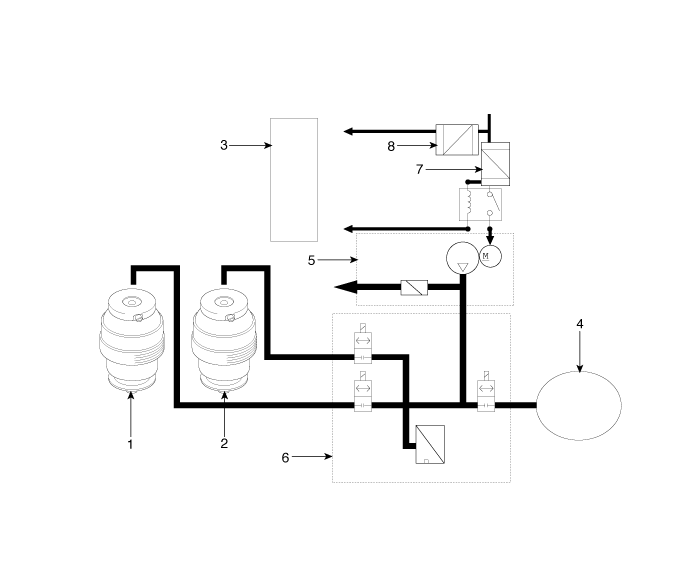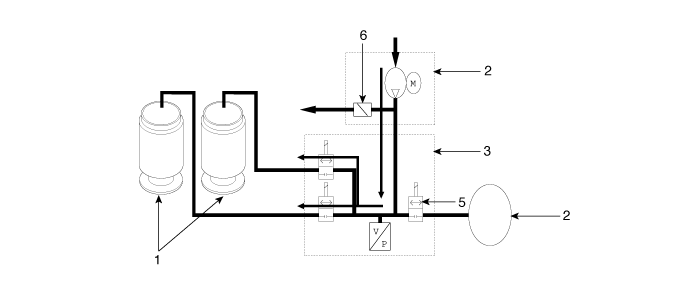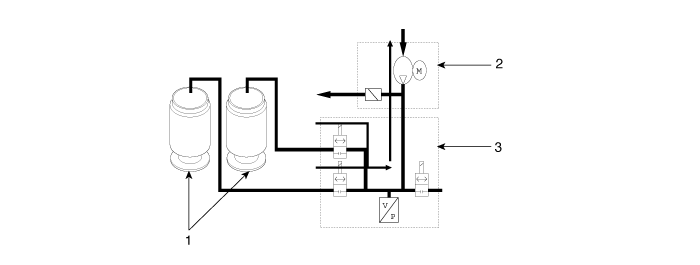
As shown in the picture, the overall layout is simple because the rear side only has an air spring (2 corner system). The system consists of two air springs and height sensors, control module, pneumatic components such as reservoir tank, compressor (temperature sensor is embedded), solenoid valve block assembly (pressure sensor is embedded) and ESC switch. Also the air tube is connected to all relevant components to implement the pneumatic control system.
When the vehicle level is lifted, the system intakes the ambient air so that it is called ‘Open Loop’ type.
As it is explained in the section of system layout, the close loop has some merit comparing the existing open loop type applied in Centennial.
In case of open loop type, system intakes the air from atmosphere and compresses it whenever necessary, therefore the system response time (leveling control time) is long. Even Lexus takes several minutes for controlling the vehicle level.

1. Air spring 2. Airspring 3. ECU 4. Reservoir tank | 5. Compressor assembly 6. Solenoid valve 7. 40A Fuse 8. 15A Fuse |
This job should be done whenever the system components were replaced with new one (except the electrical sensor or control module). Using air filling machine, supply the air to the air filling valve offered in the LH side of engine room. Air will flow to reservoir tank, compressor and will arrive in the air springs.
Due to the length of air tube and location, at first the front air spring is fulfilled and the rear air spring will be completed later on.
The vehicle has to be lifted up. (The air spring (rubber) may be bent if the air spring was empty when the system filling starts)
- IG ON and the particular mode in the scanner are required but engine starting is not necessary
(Refer to the section of ‘System air filling procedure’ for more detail information)
While the system air filling, the compressor (built in vehicle) does not operate.
There are two kinds of air filling;
System air filling: the external air pressure is supplied at the factory or workshop (1 time) the vehicle compressor does not operate. It is not possible to do this filling by vehicle compressor. The overload of compressor must be avoided and furthermore, the vehicle compressor will not operate if the air pressure (volume) is too low. (Less than 80 ~ 120 bar-liter)
Garage air filling (Supplementary filling): whenever the supplemental air is required in the system, the air is filled by the vehicle compressor.
Depending on the capacity and the pressure of the air filling machine, the whole time to complete differs but mostly it takes around 50 sec.
The target air pressure level at each component is;
Front air spring: around 7.5bar, Rear air spring: around 8.5bar, Reservoir: around 9~10bar.
However, it may change with a little amount in the case of air spring depending on the weight of vehicle (passenger & baggage)

1. Air spring 2. Compressor assembly 3. Solenoid valve | 4. Reservoir tank 5. Pressure sensor 6. Exhaust valve |
By operating the compressor, the compressed air inside reservoir tank will be moved into the air spring via solenoid valve block in order to lift up the vehicle height. During lifting mode, the air does not pass the dryer as shown in the picture. The front rear springs are lifted at first and then front springs are followed when lift the vehicle. The reason is to reduce the air resistance while driving and avoid giving an excessive headlamp beam to the driver in opposite direction lane on the road for the safety.

1. Air spring 2. Compressor assembly 3. Solenoid valve |
Whenever lowering the vehicle, the dryness is accomplished by flow the air through dryer as shown in the picture. The reverse valve and air spring valves are open so that the compressed air comes out from the air spring. At the same time, the compressor is operated so that the air passes through the dryer in order to store dried air into the reservoir tank. Be sure that even during the process of lowering, the compressor will operate in normal condition (as long as the compressor and compressor relay is normal).
Of course, if the compressor or compressor relay is failed, the lowering (down-leveling) is available by operating the ambient valve (No. 7 in the picture) only like a process of ‘air discharge’ but this is done only in case of emergency condition.
For example, the vehicle is running with high level and the compressor (or relay) failure is detected, if the vehicle speed is higher than 70kph for 10sec or more, the vehicle height should be lowered to normal level by ambient valve for the safety and lower fuel consumption.